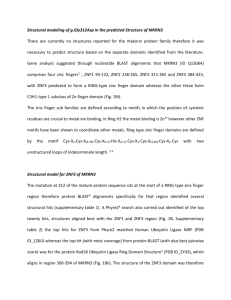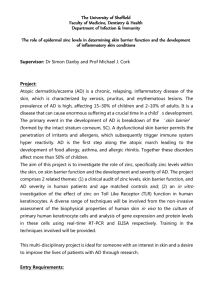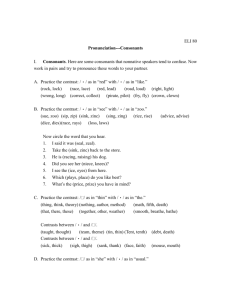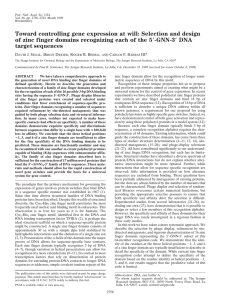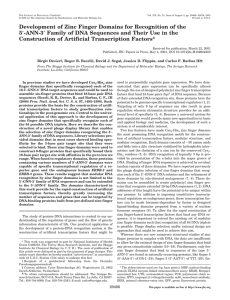here
advertisement
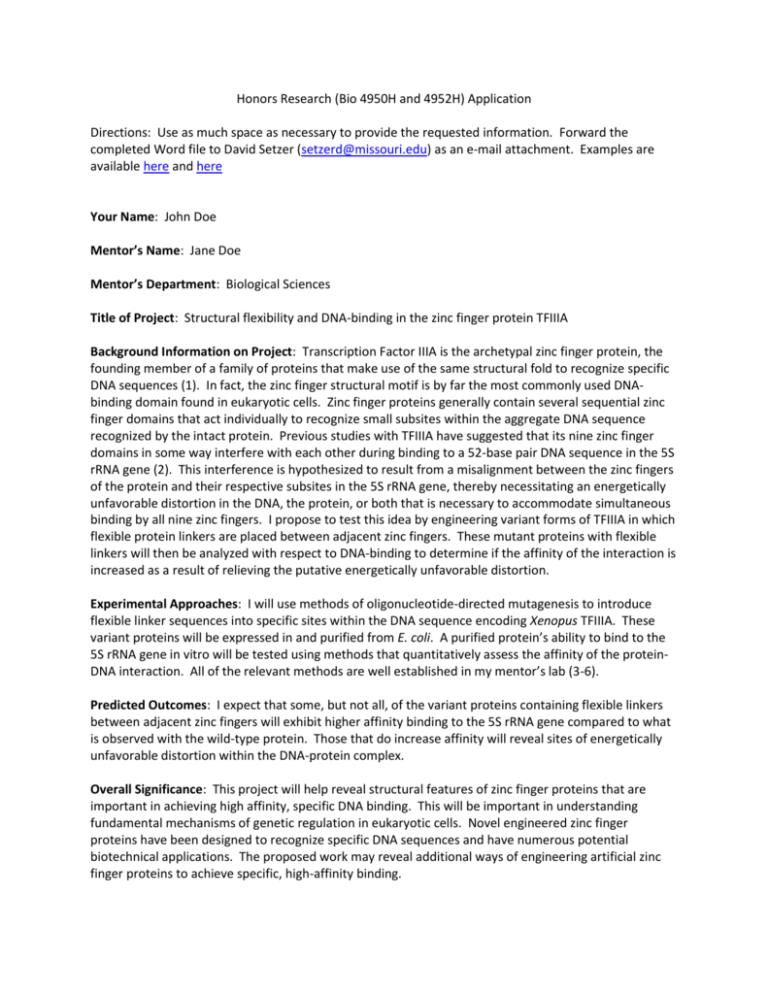
Honors Research (Bio 4950H and 4952H) Application Directions: Use as much space as necessary to provide the requested information. Forward the completed Word file to David Setzer (setzerd@missouri.edu) as an e-mail attachment. Examples are available here and here Your Name: John Doe Mentor’s Name: Jane Doe Mentor’s Department: Biological Sciences Title of Project: Structural flexibility and DNA-binding in the zinc finger protein TFIIIA Background Information on Project: Transcription Factor IIIA is the archetypal zinc finger protein, the founding member of a family of proteins that make use of the same structural fold to recognize specific DNA sequences (1). In fact, the zinc finger structural motif is by far the most commonly used DNAbinding domain found in eukaryotic cells. Zinc finger proteins generally contain several sequential zinc finger domains that act individually to recognize small subsites within the aggregate DNA sequence recognized by the intact protein. Previous studies with TFIIIA have suggested that its nine zinc finger domains in some way interfere with each other during binding to a 52-base pair DNA sequence in the 5S rRNA gene (2). This interference is hypothesized to result from a misalignment between the zinc fingers of the protein and their respective subsites in the 5S rRNA gene, thereby necessitating an energetically unfavorable distortion in the DNA, the protein, or both that is necessary to accommodate simultaneous binding by all nine zinc fingers. I propose to test this idea by engineering variant forms of TFIIIA in which flexible protein linkers are placed between adjacent zinc fingers. These mutant proteins with flexible linkers will then be analyzed with respect to DNA-binding to determine if the affinity of the interaction is increased as a result of relieving the putative energetically unfavorable distortion. Experimental Approaches: I will use methods of oligonucleotide-directed mutagenesis to introduce flexible linker sequences into specific sites within the DNA sequence encoding Xenopus TFIIIA. These variant proteins will be expressed in and purified from E. coli. A purified protein’s ability to bind to the 5S rRNA gene in vitro will be tested using methods that quantitatively assess the affinity of the proteinDNA interaction. All of the relevant methods are well established in my mentor’s lab (3-6). Predicted Outcomes: I expect that some, but not all, of the variant proteins containing flexible linkers between adjacent zinc fingers will exhibit higher affinity binding to the 5S rRNA gene compared to what is observed with the wild-type protein. Those that do increase affinity will reveal sites of energetically unfavorable distortion within the DNA-protein complex. Overall Significance: This project will help reveal structural features of zinc finger proteins that are important in achieving high affinity, specific DNA binding. This will be important in understanding fundamental mechanisms of genetic regulation in eukaryotic cells. Novel engineered zinc finger proteins have been designed to recognize specific DNA sequences and have numerous potential biotechnical applications. The proposed work may reveal additional ways of engineering artificial zinc finger proteins to achieve specific, high-affinity binding. Cited Literature: 1. Miller, J., McLachlan, A.D., and Klug, A. 1985. Repetitive zinc-binding domains in the protein transcription factor IIIA from Xenopus oocytes. EMBO J. 4:1609-1614. 2. Kehres, D.G., Subramanyan, G.S., Hung, V.S., Rogers, G.W.Jr., and Setzer, D.R. 1997. Energetically unfavorable interactions among the zinc fingers of transcription factor IIIA when bound to the 5 S rRNA gene. J. Biol. Chem. 272:20152-20161. 3. Setzer, D.R., Hmiel, R.M. and Liao, S. 1990. A simple vector modification to facilitate oligonucleotide-directed mutagenesis. Nucleic Acids Res. 18, 4175-4178. 4. Del Rio, S. and Setzer, D.R. 1991. High yield purification of active Transcription Factor IIIA expressed in E. coli. Nucleic Acids Res. 19, 6197-6203. 5. Del Rio, S., Menezes, S., and Setzer, D.R. 1993. The function of individual zinc fingers in sequence-specific DNA recognition by Transcription Factor IIIA. J. Mol. Biol. 233, 567-579. 6. Setzer, D.R. 1999. Measuring equilibrium and kinetic constants using gel retardation assays. Methods in Molecular Biology 118, 115-128.

